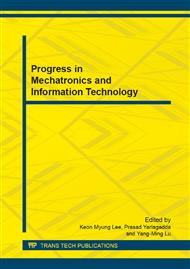[1]
R. G. Gallager, Low density parity check codes, IRE Trans. Inform. Theory, vol. IT-8, p.21–28, Jan. (1962).
DOI: 10.1109/tit.1962.1057683
Google Scholar
[2]
D. J. C. MacKay, Good error-correcting codes based on very sparse matrices, IEEE Trans. Inform. Theory, vol. 45, p.399–432, Mar. (1999).
DOI: 10.1109/18.748992
Google Scholar
[3]
Tanner, R. M, A recursive approach to low complexity codes, IEEE Trans. Inform. Theory, 1981, 27, (5), p.533– 547.
DOI: 10.1109/tit.1981.1056404
Google Scholar
[4]
S. Y. Chung, G. D. Forney, Jr, T. J. Richardson, and R. Urbanke. On the design of low-density parity-check codes within 0. 0045 dB of the Shannon limit,, IEEE Commun. Lett , vol. 5, pp.58-60, Feb. (2001).
DOI: 10.1109/4234.905935
Google Scholar
[5]
Zengyou Sun, Jin Zhang, Juan Du, Research of LDPC Decoding Based on LLR BP Algorithm, Cross Strait Quad-Regional Radio Science and Wireless Technology Conference (CSQRWC), vol. 2, 2011, p.889 – 892.
DOI: 10.1109/csqrwc.2011.6037098
Google Scholar
[6]
Laouini, N, Ben. Hadj. Slama, L, Bouallegue,A. Fast decoding of low density parity check codes, High Capacity Optical Networks and Enabling Technologies (HONET), 2012, pp: 052 – 056.
DOI: 10.1109/honet.2012.6421434
Google Scholar
[7]
J. Chen, A. Dholakia, E. Eleftheriou, M.P.C. Fossorier, Reduced complexity decoding of LDPC codes, IEEE Trans. Commun. USA, vol. 53, no. 8, pp.1288-1299, Aug. (2005).
DOI: 10.1109/tcomm.2005.852852
Google Scholar
[8]
Papaharalabos, S., Sweeney, P., Evans, B. G, Albertazzi, G. Vanelli-Coralli, A., and Corazza, G.E. Performance evaluation of a modified sum-product decoding algorithm for LDPC codes, Proc. 2nd Int. Symp. Wireless Commun. Systems (ISWCS), Siena, Italy, p.800–804, Sep. (2005).
DOI: 10.1109/iswcs.2005.1547819
Google Scholar
[9]
S. Howard, C. Schlegel, and V. Gaudet. A degree-matched check node approximation for LDPC decoding, In Proceedings of the IEEE intl. Symposium on Information Theory, ISIT, Adelaide, Australia, pp.4-9, (2005).
DOI: 10.1109/isit.2005.1523516
Google Scholar
[10]
A, Reza, Banihashemi, Amir,H., A. Mahmoud, S. Hamid, LLR Approximation for Wireless Channels Based onTaylor Series and its Application to BICM With LDPC Codes, Transactions, 2012, 60, (5). pp: 1226-1236.
DOI: 10.1109/tcomm.2012.030712.110142
Google Scholar
[11]
Ying Wang, Lei Xie, Huifang Chen, Kuang Wang, Improved Decoding Algorithm of Bit-Interleaved Coded Modulation for LDPC Code, IEEE Trans. Broadcasting. pp.103-109, Mar. (2010).
DOI: 10.1109/tbc.2009.2036950
Google Scholar


